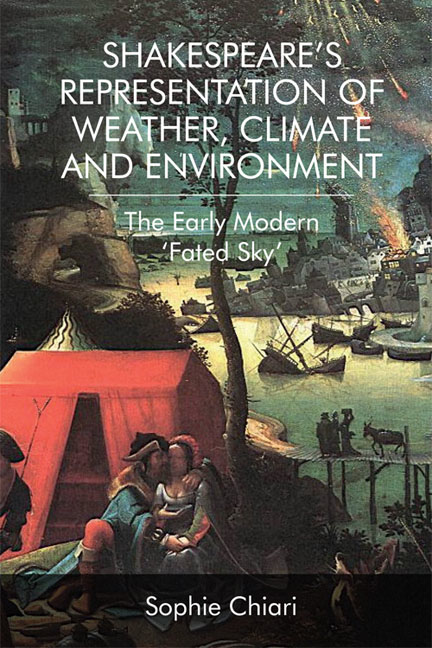Book contents
- Frontmatter
- Contents
- Illustrations
- Acknowledgements
- Textual Note
- Introduction
- 1 ‘We see / The seasons alter’: Climate Change in A Midsummer Night's Dream
- 2 ‘[T]he fire is grown too hot!’: Romeo and Juliet and the Dog Days
- 3 ‘Winter and rough weather’: Arden's Sterile Climate
- 4 Othello: Shakespeare's À bout de souffle
- 5 ‘The pelting of [a] pitiless storm’: Thunder and Lightning in King Lear
- 6 Clime and Slime in Anthony and Cleopatra
- 7 The I/Eye of the Storm: Prospero's Tempest
- Conclusion: ‘Under heaven's eye’
- Bibliography
- Index
7 - The I/Eye of the Storm: Prospero's Tempest
- Frontmatter
- Contents
- Illustrations
- Acknowledgements
- Textual Note
- Introduction
- 1 ‘We see / The seasons alter’: Climate Change in A Midsummer Night's Dream
- 2 ‘[T]he fire is grown too hot!’: Romeo and Juliet and the Dog Days
- 3 ‘Winter and rough weather’: Arden's Sterile Climate
- 4 Othello: Shakespeare's À bout de souffle
- 5 ‘The pelting of [a] pitiless storm’: Thunder and Lightning in King Lear
- 6 Clime and Slime in Anthony and Cleopatra
- 7 The I/Eye of the Storm: Prospero's Tempest
- Conclusion: ‘Under heaven's eye’
- Bibliography
- Index
Summary
If as the windes and waters here below
Do flie and flow,
My sighs and tears as busie were above;
Sure they would move
And much affect thee, as tempestuous times
Amaze poor mortals, and object their crimes.
The shadow of death by drowning hangs over the very first scene of The Tempest: a sensational stage direction, ‘A tempestuous noise of thunder and lightning heard’ (1.1.0 s.d.), probably by Ralph Crane, precedes its actual opening. In it, the term ‘lightning’ is intended as ‘an auditory effect’ rather than as a visual one, since pyrotechnics were avoided in private theatres because of the long-lasting stink they provoked. The distinction we now make between thunder and lightning must therefore have been non-existent for the audience of the Blackfriars, the indoor playhouse for which the play was written. Yet in the 1623 Folio, where it was first published, this difference subsisted, and it provided Shakespeare's early readers with an auditory, visual and sensitive experience right from the start. While the thunder was associated with the horrifying noise of a severe storm, the word ‘lightning’ not only conjured up the idea of an intense and short-lived light but, for the literati, it could also suggest the blowing of the wind. The pseudo-Aristotelian treatise On the Cosmos explains for instance that ‘[i]n the breaking up of the cloud, the wind, because it is set on fire and made to shine, is called lightning’.
‘Blow till thou burst thy wind, if room enough!’ (1.1.7–8), the boatswain madly exclaims a few lines later. Shakespeare quickly plunges readers and playgoers into the middle of a frightening tempest, seen from the sea, which threatens the lives of boatswain and captain as well as those of all the onboard passengers. The storm looks like some ultimate ordeal, as was already the case for Claudio, who, in Measure for Measure, associates death and afterlife with the ‘viewless winds’ (3.1.124) with the fear that our spirits may ‘bathe in fiery floods’ (3.1.122) or ‘reside / In thrilling region of thick-ribbèdice’ (3.1.122–3). This ordeal is both an external and an internal one. If Herbert the poet uses the storm to convey psychological turmoil in The Temple (1633), Shakespeare the playwright graphically pictures feelings of terror in terms of apocalyptic weather imagery.
- Type
- Chapter
- Information
- Shakespeare's Representation of Weather, Climate and EnvironmentThe Early Modern ‘Fated Sky’, pp. 217 - 255Publisher: Edinburgh University PressPrint publication year: 2017



